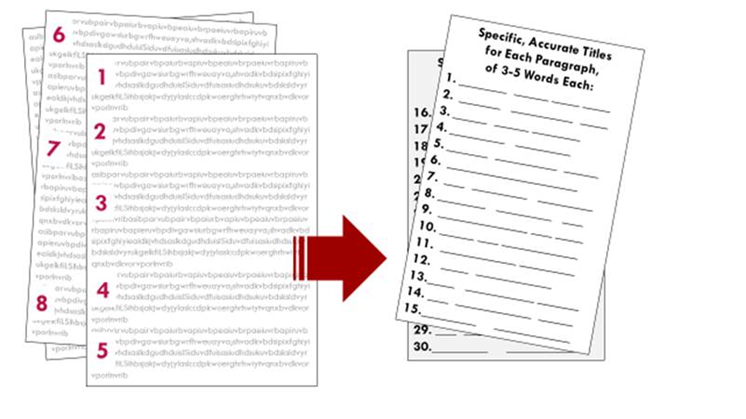Many writers find it helpful to review a rough draft in terms of the bigger picture, before they edit it at the sentence level. At this stage of writing, it is important to determine if your paper has clearly articulated main points with supporting evidence, discusses the relationships among those points, and shows the organized progression of a well-supported argument. A reverse outline is an efficient way for writers to assess their writing for these critical elements.
Some writers like to create an outline before they draft a paper; a reverse outline is something writers create after they write a draft. A reverse outline can help you make sense of what you’ve done, especially with a paper that needs its paragraphs reordered, or has paragraphs packed too tightly with too many ideas.

- Go through the draft and number each paragraph.
- On a separate page, record the number of each paragraph and its main point(s) in just a few words. Having trouble identifying the main point of a paragraph? It’s probably one of two problems:
- You may have more than one idea packed into that paragraph. See if you can identify multiple competing ideas in it; at some point soon you will need to give each its own paragraph, or perhaps delete the “extra” ideas if they aren’t needed.
- You may have a paragraph that lacks substantial points. See if the paragraph is moving toward a main point but hasn’t yet articulated one; perhaps you can articulate it now. Alternatively, you might cut that paragraph entirely or move some of its more valuable content to another paragraph that includes a closely related idea.
- Go through the entire paper this way. When you have finished, you will have an outline providing you with an overview of your paper.
 Look carefully at your outline, asking yourself the following questions:
Look carefully at your outline, asking yourself the following questions:
- Does each paragraph have just one main idea?
- Do all of your main ideas create a coherent story in the order in which they appear?
- Is there repetition of ideas?
- Are there gaps in your argument?
- When you look at the outline as a whole, does the organization reflect what you promised in your intro/thesis? If not, revise either your thesis or your paragraph order.
Booth, W.C., Colomb, G.G., Williams, J.M., Bizup, J., & Fitzgerald, W.T. (2016). The Craft of Research, Fourth Edition. University of Chicago Press.
Your answers to these questions will guide you as you revise your paper for a stronger, clearer argument. You may also find it helpful, at this point, to review our advice on writing paragraphs and thesis statements.
A final tip: if you are having difficulty developing a strong thesis statement or argument, consider reviewing your course’s description and learning objectives in the syllabus. Identifying key course themes or learning objectives can lend some direction or focus to your argument.